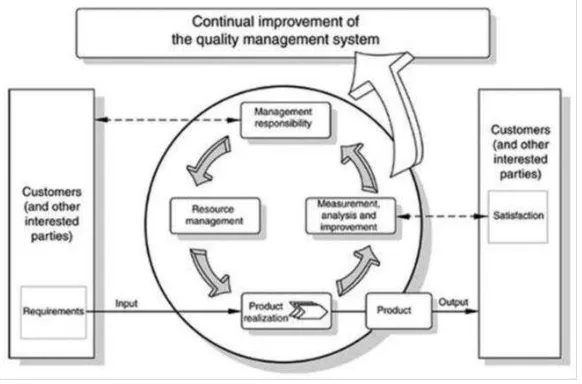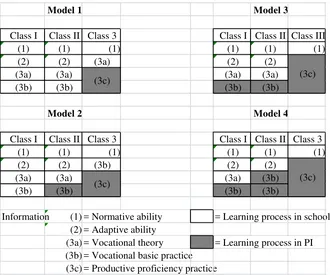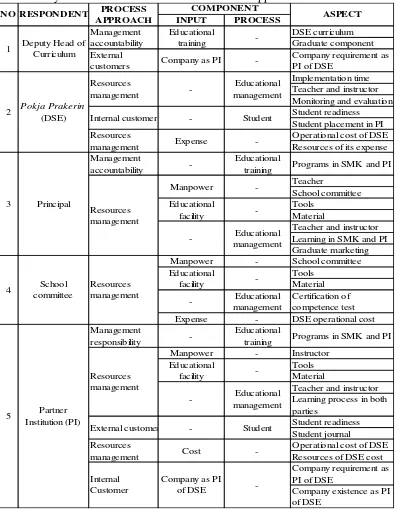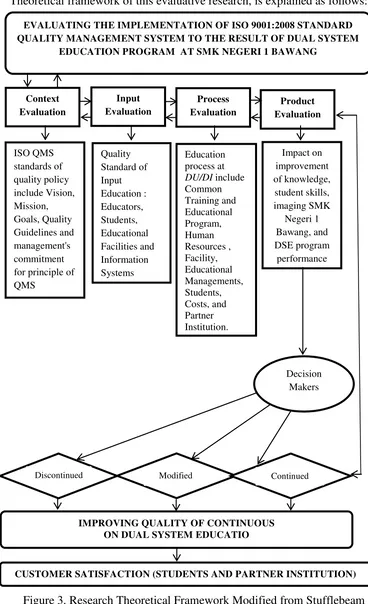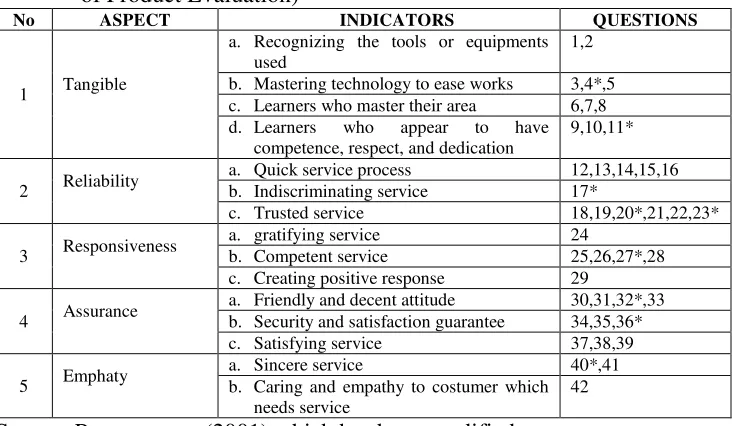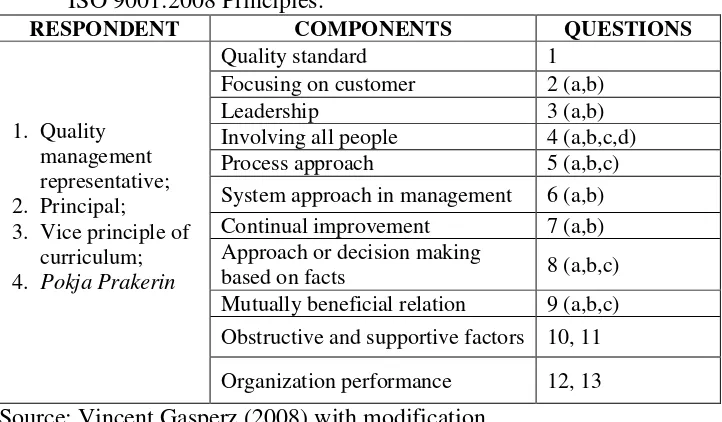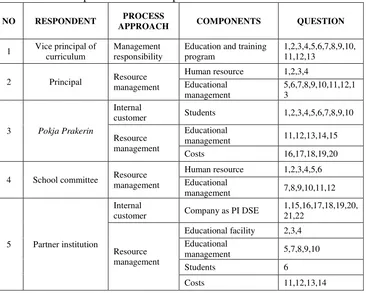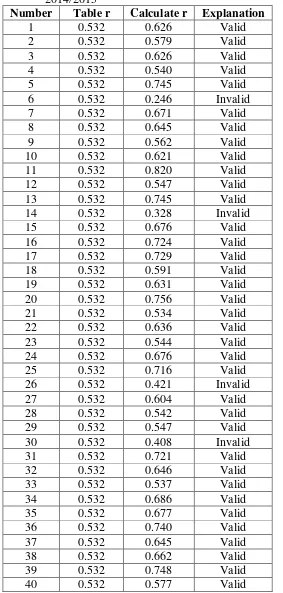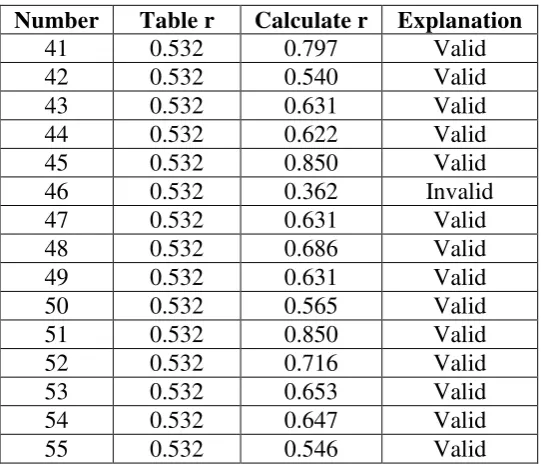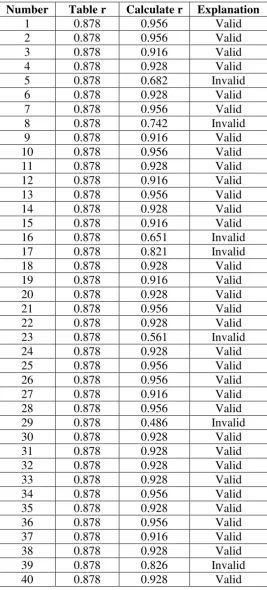EVALUATING THE IMPLEMENTATION OF ISO 9001:2008 STANDARD QUALITY MANAGEMENT SYSTEM TO THE RESULT
OF DUAL SYSTEM EDUCATION PROGRAM
IN ACCOUNTING PROFICIENCY AT SMK NEGERI 1 BAWANG IN THE ACADEMIC YEAR OF 2015/2016
UNDERGRADUATE THESIS
This undergraduate thesis is submitted in partial fulfillment of the requirement to obtain the degree of Bachelor of Education in Faculty of Economics
Yogyakarta State University
By:
Fandi Galang Wicaksana 12818244001
COVER
ACCOUNTING EDUCATION STUDY PROGRAM ACCOUNTING EDUCATION
FACULTY OF ECONOMICS YOGYAKARTA STATE UNIVERSITY
v MOTTO
“Barang siapa bertaqwa pada Allah, maka Allah memberikan jalan keluar kepadanya dan memberi rezeki dari arah yang tidak disangka-sangka dan barang siapa yang bertaqwa pada Allah, makaAllah jadikan urusannya menjadi mudah”. (Q.S Ath Thalaq : 2:4)
“Verily, with the hardship, there is relief, so when you have finished (from your occupation), then stand up for Allah worship. And Allah is the only one you can hope for”.
(QS. Al-Insyirah: 6-8).
Don’t put till tommorow what you can do today
(The Writer)
DEDICATIONS
With the mercy of God the Almighty, this simple work is dedicated to: My Parent, Suhardi, and Sri Wahyuni, who always provide me their best support and prayer along my life.
My beloved sister, Ratih Puspitasari who always encourage me in every situation.
vi
EVALUASI PENERAPAN SISTEM MANAJEMEN MUTU BERSTANDAR ISO 9001: 2008 TERHADAP HASIL PELAKSANAAN PROGRAM PENDIDIKAN SISTEM GANDA PADA PROGRAM KEAHLIAN
AKUNTANSI SMK NEGERI 1 BAWANG TAHUN AJARAN 2014 / 2015
Oleh:
FANDI GALANG WICAKSANA 12818244001
ABSTRAK
Penelitian ini mempunyai empat tujuan yaitu Pertama, bertujuan untuk mendeskripsikan evaluasi konteks, input, proses, dan produk program PSG dengan diterapkannya sistem manajemen mutu berstandar ISO 9001:2008. Kedua, mendeskripsikan pelaksanaan PSG yang memuat tingkat efektivitas pelaksanaan PSG dengan faktor-faktor yang mempengaruhinya. Ketiga, mengetahui tingkat kepuasan pelanggan yaitu siswa dan DU/DI. Keempat, mendeskripsikan perbaikan kinerja Pokja Prakerin.
Jenis penelitian ini adalah penelitian deskriptif kuantitatif. Metode pengumpulan data yang digunakan dalam penelitian ini adalah dokumentasi, angket, wawancara, dan triangulasi. Metode analisis data yang digunakan adalah deskriptif kuantitatif dengan persentase.
Berdasarkan hasil penelitian diketahui yaitu Pertama, pelaksanaan evaluasi CIPP yaitu context, input, process, dan product dengan diterapkannya ISO 9001:2008 cukup baik. Kedua, pelaksanaan seluruh komponen PSG pada umumnya sesuai dengan ketentuan penyelenggaraan PSG, efektivitas pelaksanaan PSG pada Program Keahlian Akuntansi di SMK Negeri 1 Bawang ditinjau dari keterlaksaaan seluruh komponennya adalah efektif dengan persentase keterlaksanaan 76,2%. Ketiga, tingkat kepuasan pelanggan SMK Negeri 1 Bawang dikategorikan Puas, dari siswa dengan persentase 75,1% termasuk kategori Puas dan dari DU/DI dengan persentase 69,4% termasuk kategori Puas. Keempat, pelaksanaan ISO 9001:2008 pada program PSG di SMK Negeri 1 Bawang telah berjalan baik.
vii
EVALUATING THE IMPLEMENTATION OF ISO 9001:2008 STANDARD QUALITY MANAGEMENT SYSTEM TO THE RESULT
OF DUAL SYSTEM EDUCATION PROGRAM
IN ACCOUNTING PROFICIENCY AT SMK NEGERI 1 BAWANG IN THE ACADEMIC YEAR OF 2015/2016
By: 9001:2008 standard quality management system. Second, describes DSE implementation that contains about DSE implementation effectiveness. Third, find out the level of customer satisfaction, namely students also DU/DI. Fourth, describes performance improvement of Pokja Prakerin.
Type of this research is descriptive quantitative. Data collection methods used in this research are questionnaires, documentation, interviews and triangulation. Data analysis method used is descriptive quantitative with a percentage.
Based on the research results, it is known that: first, implementation of CIPP evaluation i.e. context, input, process, and product by implementing ISO 9001:2008 is quite good. Second, implementation of all DSE components in General in accordance with the provisions organizing of DSE, effectiveness of DSE implementation in Accounting Proficiency at SMK Negeri 1 Bawang reviewed from all of its components is effective category with the percentage of 76,2%. Third, the level of customer satisfaction at SMK Negeri 1 Bawang was in the satisfied category at 75.1% (students) also 69.4% (DU/DI). Fourth, implementation of ISO 9001:2008 on DSE program at SMK Negeri 1 Bawang have running well.
viii
ACKNOWLEDGEMENTS
Alhamdulillahirobbil’alaamiin, all praise be to Allah SWT, the Almighty, the Merciful, and the Owner of the universe who has blessed me with beautiful things in my life, so I can finish this thesis entitled Evaluating the Implementation of ISO 9001:2008 Standard Quality Management System to the Result of Dual System Education Program in Accounting Proficiency at SMK Negeri 1 Bawang in the Academic Year of 2015/2016.This thesis is written as partial fulfillment of the requirement to obtain the degree of bachelor of education.
In this thesis writing, I got supports from many people. Therefore, in this opportunity I would like to thank:
1. Prof. Dr. Rochmat Wahab, M.Pd.,M.A., the Rector of Yogyakarta State University
2. Dr. Sugiharsono, M.Si., the Dean of Faculty of Economics of Yogyakarta State University
3. Abdullah Taman, M.Si., my supervisor who always guided me during this thesis writing
4. Dhyah Setyorini, M.Si., the sources person who always gave comments ang suggestions in this thesis writing
5. Drs. Purwanto, the Principal of SMK Negeri 1 Bawang who allowed me to did my research at the school
6. Eri Kusumawati, S.Psi, the Quality Management Representative of SMK Negeri 1 Bawang who gave suggestions during my research
7. Suhardi, S.Pd, the Head of Development School of SMK Negeri 1 Bawang who gave suggestions during my research
8. Maryanto, S.Kom, the Vice Principal of Curicullum of SMK Negeri 1 Bawang who gave suggestions during my research
x
B. Problem Identification ... 13
C. Problem Limitation ... 14
D. Problem Formulation ... 14
E. Objectives of the Research ... 15
F. Benefits of the Research... 16
CHAPTER II THEORETICAL BACKGROUND ... 18
A. Theoretical Review ... 18
1. Review of Educational Program Evaluation ... 18
2. Review of ISO 9001:2008 Quality Management System ... 26
3. Review of Dual System Education ... 42
4. Implementation Effectiveness of Dual System Education with ISO 9001:2008 Standard Quality Management System. ... 61
B. Relevant Research ... 67
C. Theoretical Framework ... 72
xi
CHAPTER III RESEARCH METHOD ... 80
A. Research Design ... 80
B. Research Settings ... 81
C. Research Subject and Object ... 81
D. Operational Definition ... 82
E. Data Collecting Method ... 83
F. Research Instruments ... 85
G. Instrument Testing ... 91
H. Research Procedures ... 99
I. Data Analysis Techniques ... 100
CHAPTER IV RESULTS AND DISCUSSION ... 103
A. Description of Research Results ... 103
B. Discussion ... 178
C. Research Limitation ... 236
CHAPTER V CONCLUSIONS AND RECOMMENDATIONS ... 237
A. Conclusion ... 237
B. Implication ... 241
C. Recommendation... 241
REFERENCE ... 245
xii
LIST OF TABLE
1 Component and Aspect of Monitoring and Evaluation of Dual System
Education modified with Process Approach ... ...64
2 Rating Component of Student Satisfaction ... ...65
3 Rating Component of Partner Institute Satisfaction... ...65
4 Blueprints of Implementation of Quality Management System on DSE (Components of Input and Process Evaluation) ... ...87
5 Blueprint of Student’s satisfaction in DSE (Product Evaluation Component)... ...88
6 Blueprint of Satisfaction Questionnaire of Partner Institution (Product Evaluation Component) ... ...89
7 Blueprint of Quality Management System Implementation Toward ISO 9001:2008 principles. ... ...90
8 Blueprint of ISO 9001:2008 Process Approach Interview Toward DSE Implementation Components ... ...91
9. Result of Student Satisfaction Instrument Validity Test on DSE Program in SMK Negeri 1 Bawang of 2014/2015 Academic Year ... ...93
10. Statement Item Distribution of Student Satisfaction Instrument Validity Test on Each Aspect ... ...94
11. Validity Test Result of Industrial and Business World Satisfaction Instrument on DSEProgram in SMK Negeri 1 Bawang of 2014/2015 Academic Year ..95
12. Statement Item Distribution of Industrial and Business World Satisfaction Instrument Validity Test on each aspect ... ...96
13 Interpretation of Reliability Coefficient Score ... ...97
14 The Test Result of Student Satisfaction Reliability toward DSEProgram in SMK Negeri 1 Bawang of 2014/2015 Academic Year. ... ...98
15 The result of Industrial and Business World Satisfaction Reliability toward DSEProgram in SMK Negeri 1Bawang Academic Year 2014/2015 ... ...98
16 Effectiveness and Satisfaction Levels Core Range ... ...102
17 Data of Teacher / Staff in Pokja Prakerin ... ...112
xiv
19 Data of Space else ... ...112 20 Power Search and Absorption Graduated from SMK Negeri 1 Bawang
Year 2013/2014 until 2014/2015 ... ...117 21 Details of Using Dual System Education (DSE) Implementation Costs
Academic Year 2015/2016... ...119 22 Summary of Dual System Education Implementation in Accounting
Proficiency at SMK Negeri 1 Bawang ... ...134 23 Implementation of Common Training and Educational Program components
at SMK Negeri 1 Bawang ... ...139 24 Implementation of Human Resources components at SMK Negeri 1
Bawang. ... ...142 25 Implementation of Facility Components at SMK Negeri 1 Bawang ... ...144 26 Implementation of Educational Management Components
in SMK Negeri 1 Bawang ... ...146 27 Implementation of Students Components in SMK Negeri 1 Bawang ... ...149 28 Implementation of Costs Components at SMK Negeri 1 Bawang ... ...151 29 Implementation of Partner Institution Components in SMK Negeri 1
Bawang ... ...153 30 Summary of Factors Supporting of DSE implementation at SMK Negeri 1
Bawang ... ...158 31 Summary of Factors Inhibiting of DSE Implementation at SMK Negeri 1
Bawang ... ...160 32 Customer Satisfaction by Students on Accounting Proficiency
of Dual System Education Program at SMK Negeri 1 Bawang. ... ...164 33 Customer Satisfaction by Partner Institutions in Accounting Proficiency
of Dual System Education Program at SMK Negeri 1 Bawang. ... ...168 34 Summary of the Per Component Percentage of DSE Implementation
xv LIST OF FIGURE
1 Process Approach in ISO 9001:2008 ... ...33
2 Dual System Education Model... ...52
3 Research Theoretical Framework modified from Stufflebeam (CIPP) Model Evaluation ... ...77
4 Research Procedure ... ...99
5 Model 1 of DSE Implementation in Accounting Proficiency ... ...161
6 Histogram Results of Student Satisfaction ... ...166
xv LIST OF APPENDIX
1 Research Instruments ... ...250
2 Instrument of Validation for Research ... ...295
3 Research Data on SMK Negeri 1 Bawang ... ...299
4 Research Letter... ...313
1 CHAPTER I INTRODUCTION
A.Background of the Research
The globalization era causes competition in various aspects such as economy, politics, culture, social, and so on. It is indicated by the opening of ASEAN Economic Community in 2015 which makes the competition become strict. It is not only inside the country but also outside it or some other countries. This condition forces people to face some challenges. Therefore, the best thing to do is to actualize a better life through the improvement of quality and to create qualified human resources.
One of the efforts to make qualified human resources is through education. Education has a major role in the process of improve human resources. It is explained in law number 20 in 2003 chapter 2, which states that National Education System has functions to develop ability and build character also to make the dignity of country civilization. Those are intended to educate nation life, aimed to develop learners’ potential so that they can be faithful and pious to God, can get knowledge, creativity, become independent, and become democratic and responsible citizens. Education is expected to be able to improve nation’s life quality, educate human who has knowledge, skill, and
National Education Department or as known as Depdiknas (2001:5) elaborates that there are three core strategies of national education development and those are: (1) distributing chances for education, (2) improving educational management quality, and (3) improving the educational relevancy and quality. The decision from ministry of culture and education (in m.republika.co.id) about educational distribution shows that starting from 2016, the 12 year of education is compulsory, so it can be assumed that education becomes the main needs of citizens’ lives. This education is implemented in a one package with
Universal Education Program which consists of: SMA, MA, and SMK. UEP gives wide opportunities for Indonesians to join qualified middle schools, to be facilitated by government, to be paid by center government, district government, and society. Then, with the presence of assumption through quality guarantee adopted by educational institution, it can be stated that related institution is doing an effort in improving educational quality and its relevance, in educational management (referred to human resources as educational process manager) and output from the educational process.
Bramley (1991: 9) explains that, “there are some effective results from
human resource quality. If the human resources are professional and competent in their area, it can support the success of organization in attaining target.
In order to actualizing human resources which are qualified, government who is the caretaker of national policy attempts to actualize qualified educational development. It can be seen from curriculum improvement and development, evaluation system and educational facility renovation, learning material supplying and development, teacher training and some other educational servants. However, the truth is that government attempt has not been enough to obtain intended result in improving educational quality.
Therefore, the need of earlier attempt in improving educational quality right now before the next educational development is needed by evaluating educational results. Basically, evaluation is an important thing and is strongly needed in every educational system, because the evaluation can reflect how far the development and advancement of educational result. In addition, with the help of evaluation, the effectiveness and efficiency of program implementation which affect the progress and the regress of educational quality can be revealed. Stufflebeam (1971:47) states that the purpose of evaluation is to improve, not to prove. This statement explains that evaluation is aimed not to prove but it is to improve, develop, and revise.
accuracy and inaccuracy of program implementation for the sake of attaining program objective, 4) accomplishment of program objective which has been done compared to the program objective. Thus, the result of evaluation will be inputs or feedbacks which can be used as instrument to improve or revise.
In the other side, micro education is performed as the process of civilizing and empowering learners (Law of Republic of Indonesia number 20 in 2003 regarding national education system Chapter III, section 4, verse 3). Education can be commonly implied as planned and conscious business to realize learning process so learners are actively able to develop their potentials. In the same time, national education system must be able to interlace the quality improvement and its relevance also educational management efficiency in accordance with recent demands. In that case, planned, directed, and continuous renewal of education is required.
One of the educational renewals which focus on quality improvement is the standardization of quality management system. By implementing this quality management system, the quality of educational institution can be attained with the main goal is customer satisfaction. In addition, it is expected that there is a process of continuous refinement on school performance so that the quality and school output as an educational institution always undergoes a quality improvement from time to time.
a service industry and not as a process of production. Consequently, quality management perceives that educational product as a service industry which is a service given by educational management and all educational institution personnel for every customer in line with certain quality standard. Moreover, the organization will support the quality suitable with ISO 9001:2000 standard specifications which have been planned well. As it has been elaborated by Gaspersz (2005:17) that, “ISO 9001:2000 management system implementation
can increase the trust and satisfaction from customer through quality guarantee which is systematically organized. The process of documenting in ISO 9001:2000 shows that policy, procedure, and instruction related to the quality have been planned well.
To actualize it, therefore, SMK Negeri 1 Bawang sets quality policy as a guide to improve educational service quality. Quality policy is addressed to all school community so that the vision, mission, and learning objective can be actualized and it may meet the requirement/customer satisfaction, set out the value to good service, in learning and teaching process, and make improvement continually through Quality Management System. In addition, there are quality target and work instruction made and implemented on every educational program. With the setting of quality target, school with its human resources can carry out qualified educational program so target achievement can be fulfilled. With the presence of work instruction, school may have a guide to run the activities in attaining educational objective which is oriented in educational quality improvement.
The implementation of ISO 9001:2008 standard Quality Management System in SMK Negeri 1 Bawang is to actualize school management fitting the ISO 9001:2008 standard Quality Management System and is to obey the principle so that it can satisfy customer expectation (Document of SMK Negeri 1 Bawang Quality in 2009). Customer, in this case, is internal customer (learners, teachers, and educators) and external customer (parents, societies, and graduate users). With this implementation, the educational quality can be improved because of better commitment.
investigate graduates done by educators. The implementation of ISO 9001:2008 in academic area comprises sales skills, office administration, accounting, software manifestation, network computer technique, and dressmaking.
There is government regulation which regulates the vocational high school as educational institution that provides manpower (educational relevance). In laws number 20, 2003, section 15 related to National Education System, it is stated that vocational education is high school to prepare learners to work in certain area. It is asserted that vocational high school is high school which prioritizes learners’ ability development to certain work. There is regulation
from Ministry of Education and Culture decision number 0490/1992 about
SMK cooperation with industrial and business world which aims to improve the conformance of SMK program with working world demands that is cultivated using mutually beneficial principle and based on the ministry policy. It is defined together by the ministry and the head, Kadin in 0267a/U/1994 and 84/ KU/X/1994 at October 17, 1994 about Educational Council of National Vocation (central level), Educational Council of Province Vocation (regional level), and School Council (school level).
Thus, the implementation of SMK curriculum, the relevant learning material to competent standard in the working world, the learning activity in the class, and the practice in school and in industrial also business world, must be adapted. In order to improve the relevance and synchronize between curriculum in the school and working world demand, government sets a policy of link and match through Dual System Education.
According to work assembly of department of education and culture in 1993 (Mardi, 1997: 49-50):
“Link” is a state where education has functional relation with market demand as seen in its concept, policy, plan, and its program implementation.
“Match” is a state that developed programs are scouted and implemented in system of national education and can produce output which is able to fulfill graduate users’ demand either from type, number, or quality requirements.
So, link and match concept is the presence of relation and correspondence between educational institution and working world demand in creating skilful graduates.
In order to actualize ready-to-work graduate, school as educational institution needs to create professional worker early. Therefore, educational program in accordance with that is Industrial Field Practice (as known as
Prakerin) as the actualization of DSE. The implementation of prakerin in SMK
Based on interview result with student of AK 3, named Indriana Niti on June 23, 2015:
“…the provision of material in the form of theory and requirements related to prakerin, for some students, is not really clear. It affects students when they conduct the prakerin. Some students got confused. Moreover, there was a problem related to work placement because some students did not get the appropriate area”.
It can be concluded that educational service and school training for prakerin
program DSE has not been maximized yet. It is proven by the dissatisfaction of student toward service from school. In addition, the success of prakerin
implementation is determined by those two parties, school and partner institution.
It is supported by Mrs. Dini Kun Zuraida, S.Pd, Si. As the Head of DSE programsin SMK Negeri 1 Bawang in 2011-now, she states that:
“…not all industrial and business worlds understand the major meaning
of Prakerin, it is proven by the observation result that work placement
of training program by industrial and business worlds for accounting proficiency program is not suitable with skill acquired. They did not use their skill because they got no chance in there. Moreover, they were only asked to input the data from customer, type a letter, and so on. For other proficiency programs in SMK Negeri 1 Bawang, there is no big problem regarding industrial and business world”.
In order to anticipate those problems, the role of industrial and business worlds in prakerin program is very expected through: 1) making a curriculum together (related to competence in industrial and business worlds), 2) educational management, 3) program and result evaluation, and 4) graduate distribution (Department of Education and Culture, 1993). In that case, the industrial and business worlds need to synergize and synchronize themselves in order to maintain sustainability with the need-each-other principle and to create betterment through implementing evaluation.
In other side, based on interview result with one of industrial and business worlds representative, named Heru Cahyono on Desember 14, 2015:
“…the implementation of prakerin for this year in my working place, Post Office of Mandiraja Banjarnegara was quite different. When the time of dropping started, teacher or advisor who had responsibility to guide, direct, and give education to students were not there. Learners were only given letter of application so that they could have time to learn. Advisors did not coordinate with our party to discuss about the curriculum, training, experience giving for them though the educator came every one month. Consquently, students did not know what to do and they just followed instruction from our worker. It made learners could not learn well”.
From that interview result, it can be concluded that customer satisfaction fulfillment for industrial and business worlds as the place of prakerin is not maximized. The truth is that industrial and business worlds had tried to work maximally so that students can improve their skill directly and apply their knowledge in accordance with the condition undergone during the prakerin.
(DSE). Moreover, the school has committed to apply ISO 9001:2008, where school personnel is expected to obey the fixed requirements to achieve quality objective and customer satisfaction fulfillment (Vincent Gaspersz, 2003).
Looking at this case, the researcher is interested to do evaluation with the model of CIPP for one of programs in SMK Negeri 1 Bawang as the attempt to give input for leader as the step to take decision using the conclusion or analysis result of this research. Then, researcher may comprehend what aspects can influence the achievement level of program objective. From this evaluation result, it is expected that it can be inputs for school so that the program can be better in the next year.
Considering the implementation of ISO 9001:2008 standard Quality Management System for all proficiency program in SMK Negeri 1 Bawang,
prakerin as one of Dual System Education realization, it is implemented and
referred to Quality Management System, so that in can create good quality and educational service quality. in relation to it, based on interview result with Suhardi, S.Pd as the Head of DSE programs in SMK Negeri 1 Bawang in academic year of 2007-2011:
“….Before the implementation of ISO 9001:2000 Quality Management Standard which has been revised into ISO 9001:2008 in every proficiency program, SMK Negeri 1 Bawang in implementing prakerin
understand the achievement level of quality target in educational activity implementation (in this case DSE)”.
Then, in the end of interview, he adds:
“Problem that happened during the implementation of ISO 9001:2008 quality management standards is that all components of its educators must conduct the educational program with documented system, which is in fact, some teachers from particular programs did not do the documented quality management system because of administration task for teacher is increasing in order to fulfill the curriculum demands”.
There is a conflict between plans which have been determined and the implementation in field that refers to continual improvement which sues every component of educators to conduct documented system activity. One of ISO requirements are documented system activity program.
According to Purwadi (2012: 53-54), “….Basically, the implementation of ISO 9001:2008 standard Quality Management System in school is a major thing, because ISO 9001:2008 standard Quality Management System focuses on educational service improvement from all sectors of service in school, started form Quality Management Representative, curriculum, facility and infrastructure, public relation, student service, head of study program, counseling guidance, and administration staff to get additional score, starts from administration system on all service sector in school, has files control, has work procedure which are operational and measurable, has basic guidance which is accepted by all school community, so school has measurable and planned performance clearly that everything that is done has clear result.
the implementation of Dual System Education which emphasizes the implementation of prakerin consists of: conformance of ISO 9001:2008 standard QMS on DSE with school quality standard, DSE implementation, customer satisfaction level after the program ends and the attempt for PSG
program continual improvement.
From those explanation, researcher is interested in conducting research with the title of “Evaluating the Implementation of ISO 9001:2008 Standard Quality Management System to The Result of Dual System Education Program in Accounting Proficiency at SMK Negeri 1 Bawang in the Academic Year of 2015/2016”.
B.Problem Identification
Based on the study background above, some problems can be identified. Those problems are as follows:
1. There is still an educational development strategy which does not run as expected, either on the side of the improvement of educational management quality or educational relevance in school level.
2. Customer satisfaction (students also industrial and business worlds) on dual system education program with the implementation of quality management system conducted by school has not been optimal.
3. There is still expectation discrepancy between educational world and working world demands from the DSE.
C.Problem Limitation
This research is limited to prakerin implementation aspect as one of media to conduct Dual System Education Program to industrial and business worlds in Accounting Program on policy application of ISO 9001:2008 standard Quality Management System at SMK Negeri 1 Bawang. Aspect which is studied is on the contexts of input, process, and DSE (as known as PSG) related to customer satisfaction in SMK 1 Negeri Bawang.
D.Problem Formulation
Based on the problem identification and problem limitation above, some questions related to the problem can be formulated. These are some problem formulations:
1. Has SMK Negeri 1 Bawang applied ISO 9001:2008 standard Quality Management System on Dual System Program in accordance with the fixed quality standard seen from context, input, process, and product aspects? 2. How is the implementation of Dual System Education Program in industrial
and business worlds at SMK Negeri 1 Bawang academic year of 2015/2016 with the application of ISO 9001:2008 standard Quality Management System?
4. Has the betterment effort of Pokja Prakerin performance which affects the quality improvement of Dual System Education Program in SMK Negeri 1 Bawang.
E.Objectives of the Research
Every research has an objective or some objectives so that it can carry a meaning. Therefore, this research has some objectives and those are as follows: 1. It is to understand the conformance between ISO 9001:2008 standard Quality Management System implementation on Dual System Educational program and quality standard determined by SMK Negeri 1 Bawang, in the aspects of context, input process, and product.
2. It is to describe the implementation of Dual System Educational Program in industrial and business worlds at SMK Negeri 1 Bawang academic year of 2015/2016 with the application of ISO 9001:2008 standard Quality Management System.
3. It is to understand the internal and external customer satisfaction level in SMK Negeri 1 Bawang after the implementation of Dual System Educational Program.
F. Benefits of the Research
According to the research objectives which are going to be achieved in this research, this research is expected to give some benefits as follows:
1. Theoretically
a. This research result is expected to give inputs in order to support the study of “Evaluating the Implementation of ISO 9001:2008 Standard
Quality Management System to the Result of Dual System Education Program in Accounting Proficiency at SMK Negeri 1 Bawang in Academic Year of 2015/2016.”
b. The result of this research is expected to broaden knowledge of educational management particularly, in the implementation of ISO 9001:2008 standard quality management system to dual system education program at vocational high school.
c. The result of this research can be used as a guide for the next research which has similar research object.
2. Practically a. Schools
b. Undergraduate students
This research is a research specified to learn ISO 9001:2008 standard Quality Management System applied in dual system education program in accounting area by SMK. This research can be used by undergraduate students as reference during lecturing activity and can give more knowledge, so the students may have provisions in the future.
c. Researcher
18 CHAPTER II
THEORETICAL BACKGROUND A.Theoretical Review
1. Review of Educational Program Evaluation a. Definition of Evaluation
Evaluation is a series of activities to improve performance quality or productivity of an institution in executing its program. Through evaluation, the information about what has and has not been achieved will be acquired. After that, the information is used to refine a program. (Djemari Mardapi, 2004: 19).
That remark is supported by Stufflebeam (in Propham 1995: 25), who said that evaluation is examining something to refine the fourth assessment which are context, input, process, and product.
According to Nana Sudjana & Ibrahim (2004: 127), evaluation is defined as a process of deciding score based on certain criteria in which the process itself comprises finding and collecting data or information that is needed as a basis in determining score regarding evaluation object such as program, procedure, suggestion, way, approach, model, program result, and so on.
A Joint Committee on Standards for Evaluation (in Purwanto & Atwi Suparman, 1999: 8) defines evaluation as a process to determine a score or effectiveness of activity for the sake of making decision.
Stufflebeam and Shinkfiels (in Eko Putro Widoyoko, 2011: 3) states that:
Evaluation is a process providing information which can be used as the worth and merit deciding consideration from the attained objective, design, implementation and impact to assist decision making, assist in making responsibility and improving understanding toward phenomenon. Based on the explanation above, the essence of evaluation is to provide information which can be used to assist decision making.
That definition, then, is developed by Brinkerhoff (in Eko Puto Widoyoko, 2011: 4) and it is stated that:
Evaluation is a process which determines how far an educational objective can be attained. In the implementation of evaluation, there are seven components and those are 1) focusing the evaluation, 2) designing the evaluation, 3) collecting information, 4) analyzing and interpreting, 5) reporting information, 6) managing evaluation, 7) evaluating evaluation.
The elaboration above is supported by Ralp Tyler (in Suharsimi Arikunto, 2009: 3) who explains that:
Evaluation is a process of data collecting to decide how far, to what extent, and how educational objective has been achieved.
consideration of decision making. The purpose of evaluation is to get accurate and objective information about program or activity.
b. Definition of Program Evaluation
In educational world, program evaluation is the essential thing to be done. Before examining closely about program evaluation, it is important to know the definition of program. Arikunto dan Jabar (2010:4) state that program is a continuous activity because it carries out a policy. It is also explained that program is a sort of activities so it means that program is also a system about series of activities.
According to Tyler (in Arikunto and Jabar, 2010:5), program is a process to find out whether the objective of education has been realized. Cronbach dan Stufflebeam (in Arikunto and Jabar, 2009:5) also elaborate that program evaluation is the attempt to provide information for decision maker.
The main point of program evaluation is to carry out information collecting activity related to evaluated object and its goal to provide material for policy maker in deciding the next follow up of a program. Kaufman dan Thomas (in Arikunto, 2008:40) explain that model of program evaluation can be divided into eight parts as follows.
1) Goal Oriented Evaluation Model, developed by Tyler.
2) Goal Free Evaluation Model, developed by Scriven.
3) Formatif Sumatif Evaluation Model, developed by Michael.
4) Countenance Evaluation Model, developed by Stake.
5) Responsive Evaluaation Model, developed by Stake.
6) CSE-UCLA Evaluation Model, emphasize when the evaluation was done.
In this research, the researcher uses CIPP Evaluation Model
developed by Stufflebeam for the sake of in-depth analysis regarding context, input, process, and product or result of a educational program.
c. Definition of CIPP Model Evaluation
This evaluation model views the evaluated program as a system in which those four components (context, input, process, and product) is a whole series. However, it is not a must that the evaluator has to evaluate those components if the importance is only related to one of or some of those components in a single program.
In this research, Context, Input, Process, and Product (CIPP) which is developed by Stufflebeam becomes the focus because this research puts concern to evaluation and because this approach sees the program or project as a system so if the program fails, the revision or improvement can be made. Evaluation using CIPP Stufflebeam also assists the process of decision making for institution, in this case, educational institution.
According Stufflebeam (in Popham,2001:23), CIPP evaluation model can produce recommendation for four types of educational policy and those are 1) decision to determine the objective of education, 2) decision to determine the learning procedure design, 3) decision to improve the procedure, and 4) reexamination of decision based on procedure reaction and impact.
The explanation regarding evaluation aspects in CIPP model is as follows:
1) Context Evaluation
Therefore, context evaluation in this research will reveal the conformance between fixed program objectives, problems, and incomplete needs. In this case, context evaluation is focused on some things which become the background of the program existence such as vision, mission, and institution goal, also condition and academic environment atmosphere in SMK Negeri 1 Bawang. Context evaluation also examines the availability of qualified document in quality management representative.
2) Input Evaluation
The purpose of input evaluation is to identify and measure system capability, program strategy alternative, procedural design for strategy implementation, budget, and schedule or plan making for operating the program. Input evaluation provides data to decide how to use the sources for achieving program objectives. It is related to relevancy, practicality, budgeting, intended effectiveness, and preeminent alternatives. Therefore, input evaluation in this research is the identification of sorts of input, strategies or educational training programs, resources, and alternatives used to attain the objectives. 3) Process Evaluation
Evaluation in this stage is to help implementing decision, to what extent; the operational plan has been carried out, what should be revised. If those questions have been answered, the procedure can be monitored, controlled, and improved. Arikunto (2009) said that process evaluation refers to what activity done by the program, who will be responsible to the program, and when the program ends. In CIPP model, process evaluation is directed to how far the activity done in the program fulfilled the plan. In addition, Arikunto (2009:47) explains that there are four things should be answered in process evaluation and those are: 1) is the program implementation congruous with the schedule (in operational plan)? 2) Is the staff able to deal with the activity along the program? 3) Are the facility and infrastructure used optimally? 4) What are the obstacles faced during program implementation and is it possible to continue?
interviewing regarding implementation of research object. In this evaluation, the documentation about procedure of program implementation activity will help the activity of final analysis related to attained program result.
Therefore, process evaluation in this research comprises conformance between plan of Prakerin program operation and its implementation, monitoring and Prakerin implementation obstacle, also component implementation from research object.
4) Result/Product Evaluation
According to Arikunto and Jabar (2010, 47), product evaluation is directed to something which shows changes that happen. Product evaluation is the final stage from a series of program evaluation. The purpose of product evaluation is to measure, interpret, and assess program achievement.
In this phase, evaluation is used to assist policy maker whether the result has been attained and what to do after the program works. Thus, product evaluation is directed to something that shows changes on the input. The questions that can be asked are: what are results which have been achieved? And what to do after the program works?
forming impression and organization performance improvement grounded on standard determined by quality management after the implementation of Prakerin related to consumer satisfaction are considered in this evaluation.
2. Review of ISO 9001:2008 Quality Management System a. Quality Management System
In order to understand the quality management system, the definition about quality is needed. These are the explanations.
1) Quality Definition
Quality makes something become valuable and meaningful depended on from what side people view it. The definition of quality is observed from conventional definition which is describing direct characteristic of product such as performance, credence, easy usage, and so on. After that, based on strategic definition, quality is all things that can fulfill consumer desire or need (Gasperzs, 2001:4).
Apart from that, some experts have attempted to define quality as follows (Suardi, 2004: 21):
a) Josep Juran suggests that quality is fitness for use to fulfill need and consumer satisfaction.
c) Armand V. Fiegenbaum defines quality as full consumer satisfaction. Products or services have quality if it makes consumer satisfied.
d) Garvin declares that quality is a dynamic condition regarding human product or manpower, process and task, also environment which fulfills or exceeds consumer expectation.
Based on those definitions about quality, there are some elements which discuss the quality definition accepted universally. Then, there are some similarities explained below:
(1)Quality consists of effort to fulfill or exceed the consumer expectation.
(2)Quality comprises product, service, process, and environment. (3)Quality is the description of dynamic condition.
2) Definition of Quality Management System
Vincent Gaspersz (2003: 268-269) states that quality management system is defined as a statement about how organization applies quality management practice consistently in order to fulfill consumer need and market. There are some general characteristics of quality management system as follows:
attribute that meets the quality requirement, (3) user-based quality which is conformance or precision in product (commodities / services) usage, (4) manufacturing-based quality which is the conformance on standard requirements, and (5) value-based quality which is the excellence in competitive cost rate.
b) Quality management system focuses on consistency of working process. It consists of some documentation levels.
c) Quality management system is grounded on failure prevention so it is proactive, and does not detect reactive failure.
d) Quality management system comprises objectives, customers, outputs, processes, inputs, suppliers, and measurements for feedback and feedforward. In English, it is called: SIPOCOM-
Suppliers, Inputs, Processes, Outputs, Customers, Objectives, and
Measurements.
continuous improvement effectively for the reason that it always gives expected product for consumer or market.
3) Quality Management Requirement
Organization, educational institution or company must assure that the quality management system is documented, implemented, and refined continuously in order to meet the International Standard requirement. Willi Susilo (2003: 29-30) explains that organization should:
a) Identify the process or activity needed in the quality management system and make sure its implementation in all functions.
b) Determine sort and relation of those processes.
c) Determine the criteria and method needed so operating and controlling can proceed effectively.
d) Ensure the availability of sources and information needed to support the operating and monitoring of those processes.
e) Monitor, measure, and analyze those processes.
f) Implement actions needed to achieve planned result and effort for process improvement continuously.
“documented quality management system” and it is not a
“documentation system”. Vincent Gasperszs (2006: 57-58) explains
these as follows:
a) Benefit of Quality Management System Documentation
The benefit of this documentation is that it can be a medium to communicate and connect information as evidence that all planned things have been done and it meets the requirement, and becomes knowledge that spreads and maintains experience.
b) Scope of Quality Management System Documentation Quality Management System Documentation must cover:
(1)Documented statement from quality policy and quality goal, quality manual, documented procedure needed by International Standard.
(2)Documents by organization in order to guarantee the operating, planning effectiveness, and process control.
(3)Notes needed by International Standard. b. ISO 9001:2008 Standard Introduction
In order to know and understand ISO 9001:2008, it is important to elaborate the definition and its benefits. Those are as follows:
1) ISO 9001:2008 Standard Definition
responsible to compose new standard or revise the existing standard. Standard proposed by ISO will be prepared by Technical Committee who represents organization or industry. ISO is headquartered at Genewa, Switzerland and supervises some national certificate agencies from 135 countries around the world.
Commonly, ISO is banded with quality product. Fixed standards will be reviewed during 5 until 6 years to ensure the standard is still relevant with the development of business world. Standard decided by ISO is not technical, but it is the requirement for company or organization in its applying (Silaban, 2011). While, ISO purpose is to develop and promote international standard of an institution as market or consumer expected (James G Patterson, 2010: 3).
Some standards proposed by ISO are to fulfill consumer needs. Silaban (2011) elaborates types of standard which have been submitted as follows:
a) ISO 14000, that is an international standard for implementation of certain organization about its responsibility to environment.
b) ISO 22000, international standard for a food and beverage production to guarantee its safety for consumers.
c) ISO 27000, international standard for information system agency to be responsible for information security.
e) ISO 9000, international standard which becomes the requirement when there is company quality management system implementation.
Silaban (2011) also states that ISO 9000 standard is made by “ TC-176” and it has launched 3 series of ISO 9000 as known as “The ISO
9000 Family”, which are:
a) ISO 9000; Quality Management System – Fundamentals and Vocabulary, consist of fundamentals and quality management system concept and vocabulary also the definition used in each series.
b) ISO 9001; Quality Management System – Requirements, comprise standards launched by international organization which covers quality management requirement that should be met in quality management system implementation in ISO 9001 which emphasizes process approach.
c) ISO 9004; Quality Management System Guidelines for Performance Improvements, are organization guidelines to achieve perfection through continual improvement.
After that, ISO 9001 is international standard which regulate quality management system. Therefore, it is usually called “ISO 9001,
QMS”. Note from 2008 revealed the revision year so ISO 9001:2008
difference between 2000 and 2008 is the process effectiveness implemented in an organization (Syukur, 2010: 65).
According to Vincent Gasperzs (2001: 6), ISO 9001:2008 is not product standard because there are no product acceptance criteria or requirements to be filled by product. Thus, company or organization that implements this standard cannot apply it and cannot inspect the product toward certain standard. In this case, ISO 9001:2008 is only a quality management system, so company or organization that implements and receives ISO certificate can declare that its quality management system has met the international standard, and it is not international standard product. It is indicated with the fact that there are no more specific criteria in product testing in ISO 9001, though it does not always happen when the product will be qualified as good. The explanation about ISO 9001:2008 quality management system can be seen in the diagram below (Gaspersz, 2008:285 ).
These are some elaborations regarding figure above: (1) Customer
Customers are people who give inputs related to what to do by particular organization. In this case, customer suggestion is important inputs to determine the product process and quality served. Management has to be able to guarantee that those suggestions can be understood in organization and can be achieved. The success in organization is relevant to its ability in understanding and filling customer’s need and expectation. If the
need and expectation are completed, automatically, customer satisfaction can be realized.
(2) Management Responsibility
Management responsibility displays the management commitment to product quality which is produced before doing other activity. In this case, top management shows its ability to attain quality goals which has been determined. They have to show evidence and way to reach the organization goal. One of the evidences is the existence of management review. Management guarantees not to send inappropriate or low quality product. (3) Resource Management
facility, equipment, nature resource, and finance. The important thing in implementation is to determine who will do what. Someone who is given this task to do activity related to quality must have competence to do it. competence is based on proper education and training also skill and experience which has been acquired.
(4) Product Realization
Product realization in scheme consists of commodity or service making. Product is the result of process which comprises four categories namely service, software, hardware, and process material. Organization should plan required process to realize product which fits customer needs.
(5) Measurement, Analysis, and Improvement a) Measurement
In decision making based on reality, the measurement result data is essential. Management have to plan measurement and monitoring activity such as:
Customer satisfaction;
System performance;
Process conformance;
Product or service conformance; and
b) Analysis
In decision making, it is better to make information or measurement result which is collected accurately as the fundamental. Then, the decision or conclusion which will be addressed to know organization or company performance must be acquired and collected from accurate data and information. Data and information obtained from many sources will be analyzed to assess organization’s performance, plan, and goal
also identified improvement probability. c) Improvement
Improvement action needs will emerge if there is any discrepancy from the inside or outside. Discrepancy from the inside is related to product, process, and quality system. Discrepancy from the outside is related to customer complaint and guarantee matter.
From the scheme above, customers has an essential role because of organization process input, particularly based on customer’s need and
always be improved continually fitting customer desire and expectation which is dynamic.
Quality management system model grounded on the process showed on that Figure (1) scheme above is process relation served in 4 up to 8 elements in ISO 9001 which is going to be clarified in chapter 4 in this research. That figure indicates that customer has important role to decide requirements as inputs. Customer satisfaction monitoring intends to evaluate the information about customer perception regarding whether organization or company has met customer requirement.
2) Benefit of standard ISO 9001:2008 Implementation
There are many benefits obtained from organization or company which has applied ISO 9001:2008 standard (Gaspersz, 2002:10), those are:
a) Increasing customer satisfaction and credibility through systemic and organized quality warranty. Documentation process in ISO 9001:2008 shows that policy, procedure, and instruction related to quality have been planned well.
c) Company quality management system audit which has ISO 9001:2008 is undertaken periodically by register from registration institute so customer does not need to do quality system audit. This will safe customer expense and decrease quality system audit duplication form customer.
d) Company or organization which has ISO 9001:2008 certificate is automatically listed in registration institute, so when potential customers want to find ISO 9001:2008 certificate supplier, it is possible to contact registration institute.
e) Increasing quality awareness in organization or company.
f) Giving systematic training to laborer and organization manager through procedures and instructions which are well defined.
g) Positive changing in quality of culture from organization member because management and worker are encouraged to sustain ISO 9001:2008 which is acceptable up to three years.
Nasution (2005: 288) elaborates that the main goal of ISO 9000 is to:
a) Achieve and sustain product or service quality which is produced so it can fill customer or buyer needs continually.
b) Give trust to management that quality mentioned has been achieve and can be maintained.
c) Give credence to buyer side that the quality meant has been or will be achieved in service or product sold.
From the discussion above related to quality management system and ISO 9001:2008 standard, it can be concluded that quality management system which has ISO 9001:2008 standard is documented procedure and standard practice for system management aimed to guarantee conformance from a process and product toward needs or certain requirement decided or specified by organization and customer.
3) ISO 9001:2008 Standard Quality Management Principle
Below is the eight quality management principles stated by Vincent Gaspersz (in National Education Department, “Education Strategic Quality management System Technical Guide in Line with ISO 9001:2008 Standard”: 48-50) that is the fundamental for quality
a) Focusing on customer. Educational institution depends on internal and external customer and comprehends customer needs in the present moment or in the future. Filling and exceeding customer expectation is essential.
b) Leadership. Educational unit leader determines goals and directions of the institution. Creating and taking care of internal environment where people involve themselves fully in goal attainment of education.
c) Human resource involvement. Manpower in every level is the key of educational institution and its power in it may be able to be beneficial for education.
d) Process approach. The intended result can be achieved more efficient if the resource and activity referred are managed as a process.
e) System approach in management. Identify, comprehend, and manage process which gives benefits for effectiveness and efficiency of educational institution in reaching the goals.
f) Continual improvement. Comprehensive and continual improvement of educational institution should become the static targets.
g) Factual approach in decision making. Effective decision is based on data and information analysis.
h) Profitable relationship with supplier. Organization and supplier are depended on each other and they benefit each other in order to improve their ability to reach certain value. Thus, this relationship is based on: (a) deciding and documenting requirements to be filled by school partner; (b) increasing both organization ability to be better; and (c) selecting, reviewing, evaluating partner performance to control product or output managed.
4) Supportive Factors, Obstacles, and Attempt to Overcome Obstacle The success of ISO 9001:2008 standard quality management system implementation is influenced by some factors. According to Ek and Cheng (in Dorothea W. Ariani, 2002:174), there are some factors which support this implementation. Those factors are:
a) Commitment from top management and staff. b) Understanding about quality management system. c) Quality performance culture in organization.
d) Documented performance program and responsibility in each staff. e) Good communication from all organization either internal or
Based on those factors, the most important factor is support and commitment from top management and staff. Without that factor, the implementation of this standard will not be achieved.
After that, in the implementation of ISO 9001:2008 standard quality management system in an organization, there are some obstacles and those are as follows:
a) Lack of commitment. b) Lack of resources. c) Lack of participation. d) Lack of time constraint. e) Lack of understanding. f) Lack of monitoring. g) External limitation.
(Rudi Suardi, 2002:136)
Based on those obstacles in the implementation of ISO 9001:2008 standard quality management system, it is suggested that organization has to attempt to overcome those obstacles. There are some attempts to overcome those barriers in this implementation and those are as follows:
a) Providing infrastructure for the implementation. b) Arranging training.
c) Making performance indicator. d) Providing sufficient resource.
(Rudi Suardi, 2002:136)
performance continually so that it meets the quality standard which has been determined before.
In order to meet the quality standard and to achieve the goal of quality policy, quality objective, and operation performance/planning instruction on an educational program, in attempt to educate graduates to be professional for facing global competition today, an organization is necessary to give good educational service so satisfying output and educational customer ease, through dual system program can be realized. Dual system program is the actualization of dual system education performance. Thus, dual system education is going to be discussed in the next section.
3. Review of Dual System Education a. Definition of Dual System Education
Dual system education program is the attempt of educational institution to conduct its learning activity in school environment and outside school environment. This program is educational policy and begun when Prof. Dr. Wardiman Djojonegoro who occupied as ministry of culture and education (1994: 10) stated that, “Dual System Education
According to Department of Education and Culture (1996:7), Dual System Education is:
An implementation of professional proficiency education which combines systematically and synchronizes educational program in school and expertise mastery program which is obtained through service learning program in the working world and it is directed to achieve certain proficiency level.
Another similar explanation is stated by Pahpahan (in Made Wena, 1996:16) who suggests that:
Dual system education is the implementation of vocational proficiency education which integrates systematically and synchronizes educational program in school and expertise mastery program obtained through service learning program in relevant interest, and it is directed to achieve certain expertise ability mastery.
From those definitions above, it can be inferred that it is implicitly referred to two parties which are institutions of vocational education and industrial/business worlds that simultaneously organize educational program and vocational training so they can achieve the fixed education goals.
According to Dikmenjur (vocational high education), Dual System Education characteristic as educational implementation system and vocational training is supported by some components, cooperative organization, additional charge, and sustainability.
b. Dual System Education Components
1) Common Training and Educational Program
Educational and training program on Dual System Education are compiled equally between vocational high school and partner institution done by synchronizing between vocational high school and competence in industrial or business world(as know as DU/DI). Then, it is mapped out by its skill types which shape that competence.
Program or curriculum from institution of vocational education nowadays, is developed and compiled based on National Education System Regulation No. 20 year 2003, which shows that education responsibility must include the society. Then, PP No. 29 year 1999 chapter 3 verse 2 about Vocational High Education emphasizes student preparation to be in working area and also to develop professional attitude to be able to work in certain field.
Educational and training program in Dual System Education must be agreed together between vocational education institute and partner institution such as recognizing process standard and standard in education and training.
2) Human Resources
(Dikmenjur, 1997: 1). “Whereas Dual System Education instructor is “individual who has certain expertise/competence, and has had
entrepreneurship skill dominantly but s/he is also expected to have teaching competence (Dikmenjur, 1997: 1).
Human resources that are needed in order to implement this education are workers who have not only educational competence but also vocational proficiency and have quality insight and entrepreneurship.
3) Facility
Facility is something used to attain certain goal or help particular activity implementation. Learning process in dual system education is conducted in two places which are vocational high school and partner institution, so needs or facilities which support this learning is done simultaneously between both parties. In vocational high school, the facilities are meant to support vocational basic competence ability building to prepare the students for practice in industrial and business world.
4) Educational Management
Educational management is regulating, arranging or managing educational implementation so it can be proceeded well (Lecturer Team AP, 2010: 10)
executing which includes teacher and instructor empowering. Moreover, it performs monitoring and evaluating simultaneously between vocational high school and partner institution, which are done in two places, vocational high school and partner institution.
5) Students
Students are learners who join the learning process in vocational education institute and listed as active learners in school also have chosen certain course to be mastered.
Students are not viewed as object, but the subject in the implementation of dual system education. Here, they are not only learning about material inside the class and laboratory but also adapting in behavior and culture order transpired on industrial and business world or as known as working ethos that cannot be obtained from conventional class.
6) Costs
“Costs of the implementation of dual system education comprise
meal expense, assurance, practice material (disposable), test, certificate, administration, and report.
The implementation of dual system education is done in two places which are vocational high school and partner institution that give consequences related to its implementation costs. It becomes common responsibility between vocational high school and partner institution with group decision.
7) Partner institution
Dual system education is able to be implemented only if there is cooperation between vocational high school and related institution. This institution can provide the industrial and business world to develop vocational proficiency. Then, this institution has resources to support it and there is a willingness to cooperate with the vocational high school. This is the so-called, partner institution.
There should be a synergy between the components so it can actualize dual system education which is useful either in planning, implementing, or in evaluating phase.
c. Dual System Education Goal
